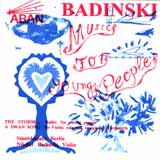1. |
Introduction |
4’17” |
2. |
1. Act - Beginning |
1’47” |
3. |
Dance |
4’05” |
4. |
Pastoral and Storm |
1’03” |
5. |
Finale |
2’32” |
6. |
Intermezzo |
2’37” |
7. |
2. Act - Actions |
8’10” |
8. |
Finale |
2’04” |
9. |
3. Act - Beginning |
1’38” |
10. |
Russian Dance |
3’39” |
11. |
Czech Dance |
2’21” |
12. |
Bulgarian Dance |
3’38” |
13. |
Ritornell |
1’27” |
14. |
Hungarian Dance |
3’34” |
15. |
Polish Dance |
1’50” |
16. |
German Dance |
3’14” |
17. |
Movement I |
0’54” |
18. |
Movement II |
0’47” |
19. |
Finale |
3’30” |
| 20. |
A Swan Song |
12’20” |
|
"The Storm..." Ballet for young People
A Swan Song
1 - 19: Staatskapelle Berlin
Joachim Freyer, Conduction / Heinz Schunk, Violin
20: Nikolai Badinski
Violin and imaginary Orchestra
(eelctroacoustic Realisation) |
THE STORM... Some listeners who know the relatively advanced musical language of most of my compositions feel that it is almost a contradiction for me to write, or even want to write, music such as this ballet for young people. Should the one necessarily exclude the other? Human beings are so multidimensional. And just as in literature and art in general, creating something simple is no easy task. Few composers today are interested in the musical world of young people. The entertainment industry, on the other hand, is all the more interested in them at a dubious aesthetic level.
My musical language today is quite different from that in the ballet music “The Storm . . .”, where I wanted to write accessible music that could open a door to the contemporary world of sound for young people (and not only for them). Clarity and intelligibility of the musical message were of particular interest to me. The orchestral groups and instruments are handled very transparently in many passages. This approach should enable the listener to recognise them and could serve further pedagogical purposes.
The language of the orchestra moves from the transparency of chamber music and the pointilistic instrumentation in the Bulgarian Dance to orchestral concentration and powerful tutti, as far as these could be achieved with a small orchestra. In spite of the intended transparency and economy, I strove for during the work on this music, I did not want to do without the creative joy of playing with instrumental colors.
Rhythmically, I wanted to write dance music that would inspire the listener to movement and physical expression. In the percussion among others glass bottles are used (Intermezzo and 2nd Act).
I attempted to integrate the folkloristic dances of Act III into the musical language of the ballet as a whole, including certain repetitions necessitated by the choreographic figures involved.
In the Introduction the main characters are presented by means of individual themes, whose transformations can be traced as the piece develops.
Because of some weaknesses in the first libretto, only the music is presented in this recording. However, the piece lends itself to other choreographies and provides a musical basis for fairy-tales.
I dedicated the stage premiere of this ballet to the embattled Chilean people in early October 1973, a few days after they had suffered the coup that led to military dictatorship. (Berlin, 1987 - N.B.)
A SWAN SONG ( Orpheus’ Song Nr. 6 ) differs greatly from the composer’s earlier piece, “The Storm ...”. It is presented on this CD together with the ballet music for orchestra (first issued on an LP in 1987 with the same cover picture) because young people suggested this combination. Listening to “A Swan Song”, they were especially excited and captivated by its fairy-tale like quality.
It is always a fascinating possibility, even a challenge, for a composer to create diverse, opposing sound structures. Two different worlds are presented here: one with a traditional orchestral language and another one with heterogeneous methods.
Electroacoustic sounds are set in juxtaposition with traditional violin playing, applying varying glissandi, micro-intervals and other musical means.
“A swan song” was commissioned by the Wittener Tage for new chamber music, where 1989 the composer played the violin solo at the premiere.(2001 – N.B.)
Nikolai BADINSKI was born in 1937 in Sofia, Bulgaria. He lived from 1962 until 1976 in East-Berlin, when he escaped to the West. He wrote numerous orchestral, chamber music, vocal, electroacoustic and ballet works. Some of these have been performed by ensembles such as the Staatskapelle Berlin, the Berlin Philharmonic Orchestra, Symphony Orchestra of the Südwestfunk in Baden-Baden, Adritti Quartet London, the Philharmonic Octet Berlin, Ensemble of the Staatskapelle Dresden, the Choir of Radio France, the Nederland Vocaal Ensemble in Hilversum, Camerata Academica Salzburg and others. He has won several important international prizes for composition, among others the Triest Prize for Symphonic Music, the Viotti and Stockhausen Prizes and also the Prix du Rome. He is member of the European Academy of Arts, Sciences and Humanities in Paris. Great personalities of the international music life value his music highly. György Ligeti characterizes it as “very refined, very highly rated in its quality.” The ‘musical Pope’ H.H. Stuckenschmidt praised the “unmistakable personal language” of his music and wrote in the Frankfurter Allgemeine Zeitung: “one is captivated until the end.” The notable musicologist, Carl Dahlhaus, has written that “Badinski combines a well-founded and many-sided musical education with an acute sense for contemporary tendencies; there is a balance between the inclination towards the experimental and an aesthetic conscience dedicated to structural unity.”
Itzhak Tamir
